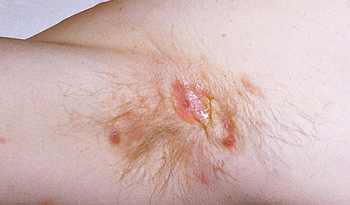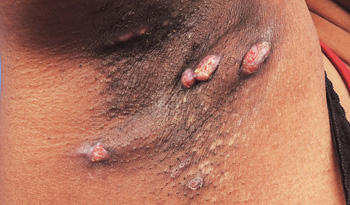Hidradenitis suppurativa (HS) is a painful, long-term skin condition that causes abscesses and scarring on the skin.
The exact cause of hidradenitis suppurativa is unknown, but it occurs near hair follicles where there are sweat glands, usually around the groin, buttocks, breasts and armpits.
For reasons that are unclear, more women than men have the condition. It’s thought to affect about 1% of the population.
Symptoms
The symptoms of hidradenitis suppurativa range from mild to severe.
It causes a mixture of red boil-like lumps, blackheads, cysts, scarring and channels in the skin that leak pus.
The condition tends to start with a firm pea-sized lesion that develops in one place. This will either disappear or rupture and ooze pus after a few hours or days.
New lumps will then often develop in an area nearby. If these aren’t controlled with medication, larger lumps may develop and spread. Narrow channels called sinus tracts also form under the skin that break out on the surface and leak pus.
Hidradenitis suppurativa is very painful. The lumps develop on the skin in the following areas:
around the groin and genitals
in the armpits
on the buttocks and around the anus (back passage)
below the breasts
The abscesses may also spread to the nape of the neck, waistband and inner thighs. Other isolated areas that have been known to be affected include the front or back of the legs, the sides, the back area and even the face.
Some of the lumps may become infected with bacteria, causing a secondary infection that will  need to be treated with antibiotics (see below).
need to be treated with antibiotics (see below).
Many people with hidradenitis suppurativa also develop a pilonidal sinus, which is a small hole or “tunnel” in the skin.
What causes hidradenitis suppurativa?
The exact cause of hidradenitis suppurativa is unclear, but the lumps develop as a result of blocked hair follicles.
Smoking and obesity are both strongly associated with hidradenitis suppurativa, and if you’re obese and/or smoke it’s likely to make your symptoms worse.
Hidradenitis suppurativa usually starts around puberty, but it can occur at any age. It’s less common before puberty and after the menopause, which may suggest that the sex hormones play a part. Many people with the condition also have acne and hirsutism (excessive hair growth).
In rare cases, hidradenitis suppurativa may be linked to Crohn’s disease, particularly if it develops around the groin area and the skin near the anus. Crohn’s disease is a long-term condition that causes the lining of the digestive system to become inflamed.
Hidradenitis suppurativa runs in families in about a third of all cases. It’s not infectious and isn’t linked to poor hygiene.
Diagnosing hidradenitis suppurativa
There’s no definitive test to help diagnose hidradenitis suppurativa.
Your GP will examine the affected areas of skin, and they may take a swab of an infected area. This can be helpful in making a diagnosis because the condition isn’t usually associated with the presence of bacteria that cause skin infections.
Hidradenitis suppurativa could potentially be mistaken for acne or folliculitis (inflammation of the hair follicles).
Treating hidradenitis suppurativa
Hidradenitis suppurativa is a lifelong, recurring condition that requires constant management and is often difficult to manage.
It’s important to try to recognise and diagnose the condition in its early stages and prevent it getting worse.
Treatment for hidradenitis suppurativa will be tailored to the individual. In the early stages, it may be controlled with medication. Surgery may be required in severe or persistent cases. The treatments are outlined below.
Surgery
Surgery may be considered in cases where hidradenitis suppurativa can’t be controlled with medication.
Lifestyle advice
If you have hidradenitis suppurativa you should:
stop smoking, if you smoke
use an antiseptic skin wash or antiseptic soap – this may be prescribed alongside other treatment (see above)
hold a warm flannel on the lumps to encourage the pus to drain
wear loose-fitting clothes
avoid shaving affected skin and avoid wearing perfume or perfumed deodorants in the affected areas
Outlook
Although hidradenitis suppurativa can persist for many years, if it’s diagnosed early the symptoms can be improved with treatment.
However, the condition can have a significant impact on a person’s everyday life. Having to regularly change dressings and constantly live with the pain, discomfort and embarrassment of the symptoms can affect your quality of life and lead to depression.
Speak to your GP if you’re having problems coping. Charities, such as The Hidradenitis Suppurativa Trust, can also provide help support.
